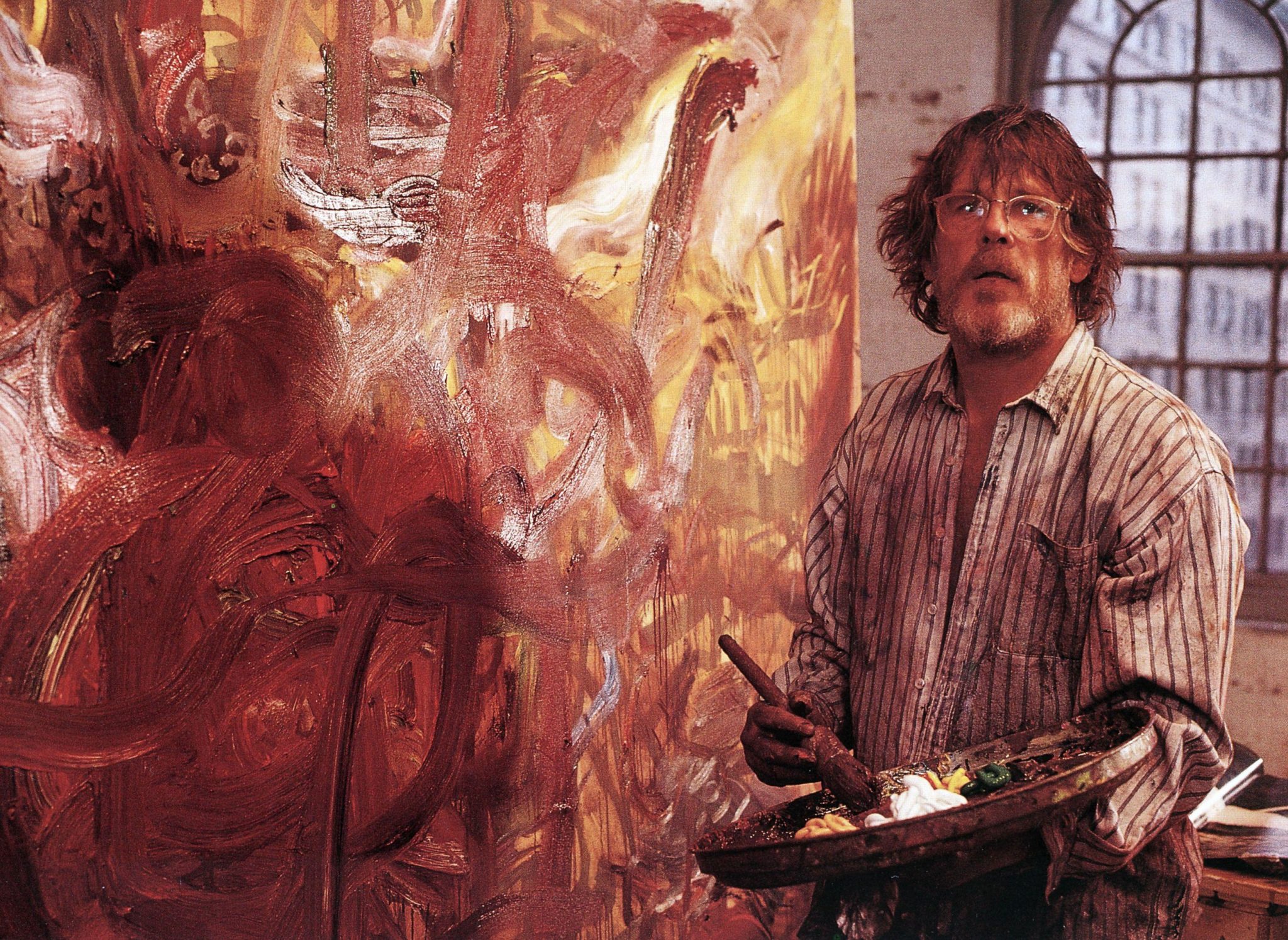This ‘new’ era of Abstract Expressionism is the perfect fit for an age of hyper-individualism and AI-powered press releases
When I was nineteen and starting out at art school, I wanted to be an abstract expressionist. But it wasn’t 1958, I didn’t know much, and my primary inspiration was not, say, the godlike Willem de Kooning but Nick Nolte’s dissolute, somewhat De Kooningesque painter character in the Martin Scorsese segment of the 1989 portmanteau film New York Stories. Nolte’s Lionel Dobie seemed to be mostly having a fine old time getting drunk, slapping paint around in a massive, big-windowed loft studio, listening to Bob Dylan very loud and existentially mooning over his female studio assistant. According to that film, Ab-Ex (and all the macho behaviour that went with it) was still a going concern, so I bought canvas, acrylics, brushes and beer and got to creating chaos in my attic bedroom.
Pretty soon, and after my dad had told me many times to turn the fucking Bob Dylan down, I did some reading and grew up a bit: I was now going to be an intellectual 1960s conceptualist instead. And a few years after that, when I’d pivoted to the much more relevant and sensible role of art critic in the twenty-first century, I was talking to a fairly successful British painter who’d been at art school in the neo-conceptual, elbows-out, Goldsmiths-centric late 80s. The painters he knew, he said, such as Glenn Brown, all idolised the Abstract Expressionists too, but they realised you couldn’t just rerun the past: you had to take gesturality and do something new with it on a formal level, tangle it up with pop culture and irony. You might still get to enjoy stroking the Winsor & Newton on, but you weren’t an epigone.
A couple of decades later we’re into a new, or ‘new’, era of Abstract Expressionism, to judge from the preponderance of neo-Ab-Ex that increasingly has been cluttering up the galleries over the past few years. (This might also be the long tail of the first touring retrospective for the historical genre for 50 years in 2016–17, at the Royal Academy in London and then Guggenheim Bilbao.) Now, at some 70 years’ remove from the original, quite a few young painters are just… doing it again, stylistically speaking. In a way that seems fairly reasonable, they are particularly licensed to do this when not either white or male or straight: see, for various examples, Li Hei Di, Rachel Jones and Carmen Neely. (To a degree, admittedly, this is also a rerun: see what Sue Williams and Cecily Brown were doing to the style in the 1990s and 2000s, and there are outrider artists in recent times too, such as Oscar Murillo.) But the form itself mostly remains strikingly recherché. This is licensed partly because it’s what constitutes, within our eternal short-term present, a kind of retro twist on ‘progress’ now: figuration came back a decade ago, and we all know what comes after figuration. (When my daughter was around seven, she excitedly came back from school with a painting she’d done of something and said the teacher had promised they’d be doing abstraction next.) Two years ago, I wrote a column foolhardily, or hopefully, asking if we’d reached ‘the endpoint of revivalism’. The verdict is now in: hell no.

The cultural products of end-of-empire eras tend to revolve around nostalgic stylistic resurgences and novelty aimed at jaded palates. (Free exhibition title: ‘Jaded Palettes’.) That seems to be, at least partly, the story here. Ab-Ex is also a good fit for an age of hyper-individualism, to judge from endless AI-powered press releases concerned with the artist bravely exploring their own interiority and feelings. Additionally, if you’re a visual-literacy-challenged collector, the combination of nice colour, a simplistic narrative and the impossibility of really reading it wrong – because it’s all about what you see amid the mist and mush – must be attractive. ‘Innovation’, where it’s present beyond the question of who made the work, lies in approaches like mixing up gesturality with nods to the rococo, as Flora Yukhnovich and Michaela Yearwood-Dan explore. (Though, again, a painter such as Katy Moran did this ages ago.)
There’s also a certain temporal logic at work here, in this ongoing do-over of yesteryears. The original Abstract Expressionism arose out of biomorphic Surrealism, and we’ve just had a Surrealism revival too, so this ‘ought’ to be next. Not that that said Surrealism has gone away, not that figurative art per se has gone away. But it’s pretty strange, if you were around the London artworld in the 1990s and 2000s, to see art that looks almost exactly like the stuff that cluttered up the less-cool galleries in the West End now being touted as some kind of vanguard, often by the galleries who were the cool galleries at the time. Circle of life, and all that. It’s stranger still that such lowered expectations for painting’s formal development have been normalising for nearly a decade now.
Will this approach last? There’s plenty more art history to plunder and sequentially recode, or just plain plunder. If so, maybe what’s coming, eventually, is less a repeat of a continual displacement of movements than an accumulation or simultaneous stacking of them in the name of avoiding anything that’s really, scare-the-horses new in visual terms. Eventually, if we haven’t been nuked, and after neo-Ab-Ex gives way to neo-neo-(don’t forget Neo Geo) hard-edge painting and thence to neo-neo (neo?)-Conceptualism and onward until the whole cycle starts again, we’ll have a kind of quantum art history, every past moment coexistent in the present tense. Though some of it will appropriately reflect changing values, most of it will look like second-rate bullshit. But hey, it’ll be our second-rate bullshit.
